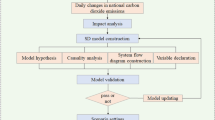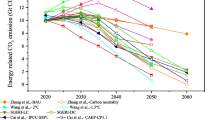Abstract
Several countries have weakened the carbon emission objectives to immediately revive the economy in the post-COVID-19 era. Therefore, it is a challenge worth addressing to readjust the economic development and carbon emissions after the COVID-19 pandemic. From the perspective of China’s carbon emissions, this study shapes a multi-objective dynamic optimization model based on the material capital input and R&D support aspects. The proposed model imitates China’s economic development, energy consumption, and carbon dioxide (CO2) emissions. The model provides theoretical suggestion for the government to revive economic development and reduce carbon emissions. In addition, this research paper compares the evolutionary path of carbon peak under the two scenarios. The first scenario requires maintaining the pre-epidemic development state and pace of carbon emission reduction, referred to as the baseline scenario (BS). The second scenario is termed the optimal scenario (OS) based on the model calculation. The study findings exhibit that China is not able to accomplish the 2030 CO2 emission peak objective, under the BS. However, China under the OS shall expectedly accomplish the 2030 carbon peak objective ahead of schedule, while the peak CO2 emissions shall be around 11.28 billion tons. Reportedly, at least 788 million tons of CO2 reduction contrasted with the BS. Furthermore, there is an 80.35% decline in energy intensity as compared to 2005. Consequently, the study results contribute theoretical guidance for the “green recovery” of China’s economy and the adjustment of carbon emission reduction’s path after the COVID-19 epidemic. Consistent with this, the research method also contributes to the theoretical research on carbon emissions at the national level while extending a new research perspective for the economic and environmental fields.








Similar content being viewed by others
Data Availability
The data that support the findings of this study are available from the corresponding author, [Shengyan Wang], upon reasonable request.
References
Ang BW, Liu FL et al (2003) Perfect decomposition techniques in energy and environmental analysis. Energy Policy 31(14):1561–1566
Beatriz Piderit, M, Vivanco F et al (2019) Net zero buildings-a framework for an integrated policy in Chile. Sustainability 11(5):1494. https://doi.org/10.3390/su11051494
Chen L, Msigwa G et al (2022) Strategies to achieve a carbon neutral society: a review. Environ Chem Lett 20(4):2277–2310
Chen Q, Wang Q et al (2023) Drivers and evolution of low-carbon development in China’s transportation industry: an integrated analytical approach. Energy 262:125614
Faubert, P, Bouchard S et al (2020) Achieving carbon neutrality for a future large greenhouse gas emitter in Quebec, Canada: a case study. Atmosphere 11(8):810. https://doi.org/10.3390/atmos11080810
He Y, Fu F et al (2021) Exploring the path of carbon emissions reduction in China’s industrial sector through energy efficiency enhancement induced by R&D investment. Energy 225:120208
Huang F, Zhou D et al (2019) Decomposition and attribution analysis of the transport sector’s carbon dioxide intensity change in China. Trans Res Part a: Policy Pract 119:343–358
Jia S, Yang C et al (2022) Heterogeneous impact of land-use on climate change: study from a spatial perspective. Front Environ Sci 10:840603. https://doi.org/10.3389/fenvs
Leal Filho W, Setti AFF et al (2022) An overview of the interactions between food production and climate change. Sci Total Environ 838:156438. https://doi.org/10.1016/j.scitotenv.2022.156438
Li A, Zhang A et al (2017) Decomposition analysis of factors affecting carbon dioxide emissions across provinces in China. J Clean Prod 141:1428–1444
Li H, Qin Q (2019) Challenges for China’s carbon emissions peaking in 2030: a decomposition and decoupling analysis. J Clean Prod 207:857–865
Lin B, Benjamin NI (2017) Influencing factors on carbon emissions in China transport industry. A new evidence from quantile regression analysis. J Clean Prod 150:175–187
Lisitano IM, Biglia A et al (2018) Building for a zero carbon future: trade-off between carbon dioxide emissions and primary energy approaches. Energy Procedia 148:1074–1081
Liu M, Yang X et al (2023) Drivers of China’s carbon dioxide emissions: Based on the combination model of structural decomposition analysis and input-output subsystem method. Environ Impact Assess Rev 100:107043
Luo X and Lin T (2023) Probabilistic sea level rise hazard analysis based on the current generation of data and protocols. J Struct Eng 149(3):4022252
Maierhofer D, Roeck M et al (2022) Critical life cycle assessment of the innovative passive nZEB building concept ‘be 2226’ in view of net-zero carbon targets. Build Environ 223:109476
Matthews HD, Zickfeld K et al (2022) Temporary nature-based carbon removal can lower peak warming in a well-below 2 degrees C scenario. Commun Earth Environ 3(65). https://doi.org/10.1038/s43247-022-00391-z
Mi Z, Wei Y et al (2017) Socioeconomic impact assessment of China’s CO2 emissions peak prior to 2030. J Clean Prod 142:2227–2236
Pan X, Xu H et al (2021) Forecasting of industrial structure evolution and CO2 emissions in Liaoning Province. J Clean Prod 285:124870
Quan C, Cheng X et al (2020) Analysis on the influencing factors of carbon emission in China’s logistics industry based on LMDI method. Sci Total Environ 734:138473
Shan H (2008) Reestimating the capital stock of China: 1952~2006. J Quant Technol Econ 25(10):17–31
Sterman J, Moomaw W et al (2022) Does wood bioenergy help or harm the climate? Bull Atomic Sci 78(3):128–138
Sun L, Cui H et al (2022) Will China achieve its 2060 carbon neutral commitment from the provincial perspective? Adv Clim Chang Res 13(2):169–178
Varga J, Roeger W et al (2022) E-QUEST: a multisector dynamic general equilibrium model with energy and a model-based assessment to reach the EU climate targets. Econ Model 114:105911
Wang Z, Yang Y (2016) Features and influencing factors of carbon emissions indicators in the perspective of residential consumption: evidence from Beijing, China. Ecol Ind 61:634–645
Wu L, Zhao H et al (2022) Understanding of the effect of climate change on tropical cyclone intensity: a review. Adv Atmos Sci 39(2):205–221
Xin D, Ahmad M et al (2022) Impact of innovation in climate change mitigation technologies related to chemical industry on carbon dioxide emissions in the United States. J Clean Prod 379:134746
Xu S, He Z et al (2014) Factors that influence carbon emissions due to energy consumption in China: decomposition analysis using LMDI. Appl Energy 127:182–193
Yan M, Sun H et al (2022) Driving factors and key emission reduction paths of Xinjiang industries carbon emissions: an industry chain perspective. J Clean Prod 374:133879
Yang H, Li X et al (2021) Using system dynamics to analyse key factors influencing China’s energy-related CO2 emissions and emission reduction scenarios. J Clean Prod 320:128811
Yu S, Zhang Q et al (2023) Development of an extended STIRPAT model to assess the driving factors of household carbon dioxide emissions in China. J Environ Manage 325:116502
Yu S, Zheng S et al (2018) China can peak its energy-related carbon emissions before 2025: evidence from industry restructuring. Energy Econ 73:91–107
Zeng N, Jiang K et al (2022) The Chinese carbon-neutral goal: challenges and prospects. Adv Atmos Sci 39(8):1229–1238
Zeng Q, Ma F et al (2022) Policy uncertainty and carbon neutrality: evidence from China. Finance Res Lett 47:102771
Zhang S, Wang K et al (2021) Policy recommendations for the zero energy building promotion towards carbon neutral in Asia-Pacific Region. Energy Policy 159:112661
Zhang Y, Zhang X et al (2022) Robust optimization-based dynamic power generation mix evolution under the carbon-neutral target. Resour Conserv Recycl 178:106103
Zhang Y, Da Y (2015) The decomposition of energy-related carbon emission and its decoupling with economic growth in China. Renew Sustain Energy Rev 41:1255–1266
Zhao J, Jiang Q et al (2022) How does industrial structure adjustment reduce CO2 emissions? Spatial and mediation effects analysis for China. Energy Econ 105:105704
Zhou X, Zhang M et al (2017) A comparative study on decoupling relationship and influence factors between China’s regional economic development and industrial energy–related carbon emissions. J Clean Prod 142:783–800
Zhu Y, Wang Z (2014) Optimal R&D investment path for China to fulfill its emission intensity target and the corresponding economic growth path. Geogr Res 33(8):1406–1416
Zou C, Xiong B et al (2021) The role of new energy in carbon neutral. Pet Explor Dev 48(2):480–491
Acknowledgements
The authors are grateful to the editors and reviewers for their helpful comments and suggestions.
Author information
Authors and Affiliations
Contributions
Da Liu: conceptualization, methodology. Shengyan Wang: formal analysis, data curation, writing—original draft. Xudong Zhao: software, visualization. Jiaying Wang: writing- reviewing and editing.
Corresponding author
Ethics declarations
Ethical approval
This paper does not contain any studies involving humans or animals.
Consent to participate
Not applicable.
Consent to publish
Not applicable.
Competing interests
The authors declare no competing interests.
Additional information
Responsible Editor: V.V.S.S. Sarma
Publisher's Note
Springer Nature remains neutral with regard to jurisdictional claims in published maps and institutional affiliations.
Rights and permissions
Springer Nature or its licensor (e.g. a society or other partner) holds exclusive rights to this article under a publishing agreement with the author(s) or other rightsholder(s); author self-archiving of the accepted manuscript version of this article is solely governed by the terms of such publishing agreement and applicable law.
About this article
Cite this article
Liu, D., Wang, S., Zhao, X. et al. China’s carbon emissions peaking pathway in the post-COVID-19 era. Environ Sci Pollut Res 30, 100959–100978 (2023). https://doi.org/10.1007/s11356-023-29400-0
Received:
Accepted:
Published:
Issue Date:
DOI: https://doi.org/10.1007/s11356-023-29400-0




